This article was published in Scientific American’s former blog network and reflects the views of the author, not necessarily those of Scientific American
* Technically, the proper group name is Chamaeleonidae, though it often gets written Chameleonidae; the spellings Chameleontidae and Chamaeleontidae are out there in the literature as well. [Image above of Jackson’s chameleon Trioceros jacksonii by Benjamint444, CC BY-SA 3.0].
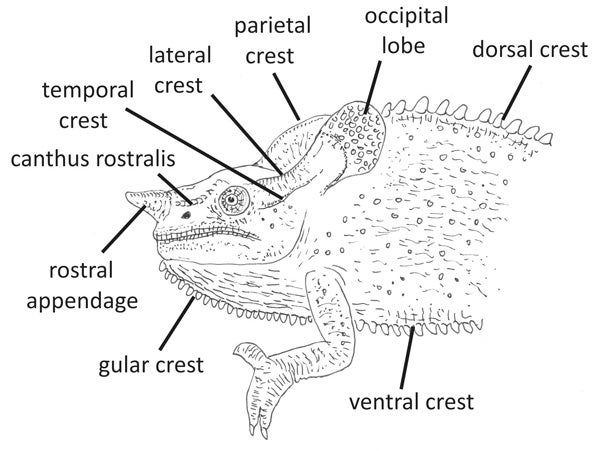
A generic hypothetical chameleon with key features labelled - so many crests. The occipital lobes are soft and mobile. That's right: soft, mobile flaps on the edge of the frill. Thanks to Mark D. Scherz for noting an error in a previous version.
The group is also notable for its substantial size variation. Species range from 20 mm (in Brookesia micra from Madagascar) to about 69 cm (in Parson’s chameleon Calumma parsonii and Oustalet’s chameleon Furcifer oustaleti). And chameleons are also notable for their remarkable variety of visual display structures. Indeed, with crests, horns, frills, lobes, lumps, spines and spurs, chameleons are among the most flamboyant of squamates, the evolution and diversity of these structures often being mentioned in discussions on the evolution of sexual and social display features. Those topics are all worthy of further discussion, but they won’t be covered here, at least not today.
On supporting science journalism
If you're enjoying this article, consider supporting our award-winning journalism by subscribing. By purchasing a subscription you are helping to ensure the future of impactful stories about the discoveries and ideas shaping our world today.
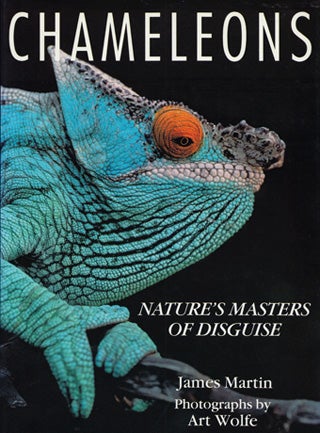
Martin (1992): buy it here.
Incidentally, as always with living reptiles there’s something of a lack of the sorts of volumes you might expect to exist on these animals. My general go-to volume on chameleons in toto is James Martin’s Chameleons: Nature’s Masters of Disguise (Martin 1992). It’s a bit dated now but it’s a nice introduction overall, the discussion of every single species known at the time of writing being a major plus point. While we’re here, I’m not a fan of the keeping of chameleons as pets. They don’t seem to do well in captivity and virtually always die young.
Say goodbye to the ‘two genera system’. If you’re a drive-by lizard fan, you’ll ‘know’ that most chameleon species – about 180 are presently recognised – are included within the large genus Chamaeleo, with the various small, weird, brown, Madagascan leaf chameleons being classified within Brookesia. At this point I should mention briefly that Madagascar is Chameleon Capital of the World, home to about half of all species.
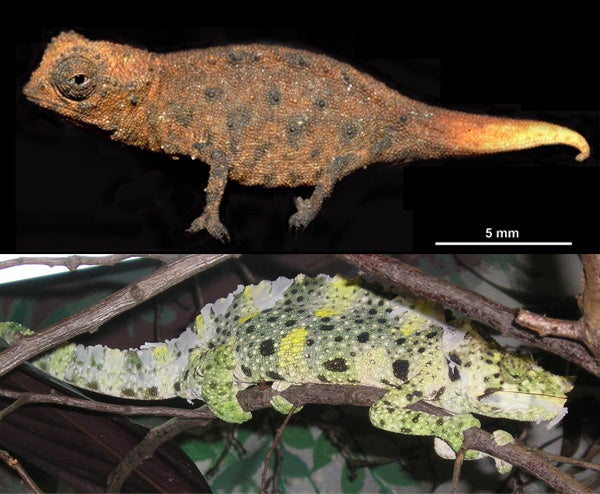
The smallest and one of the largest. At top: tiny Brookesia micra (image from Glaw et al. (2012), CC BY 2.5). Below: captive Meller's chameleon Trioceros melleri (photo by Darren Naish) - no scale bar but it's really big (c 61 cm).
This simple ‘two genera system’ was the one I learnt myself back in the 1980s. But the reason we’re here is that chameleon taxonomy is, today, far more complex than that with as many as 12 genera now recognised. Unless you’re a specialist, it might be hard to keep up. So in this and following articles, I aim to explain where we’re at as regards chameleon taxonomy and phylogeny.
Let me say to start with that experts haven’t been naming new taxa with gay abandon simply because they’ve been discovering new species deemed ‘distinctive enough’ for their own genera. Rather, the new generic epithets are linked to phylogenetic studies that reveal how distinct and disparate the various chameleon lineages are.
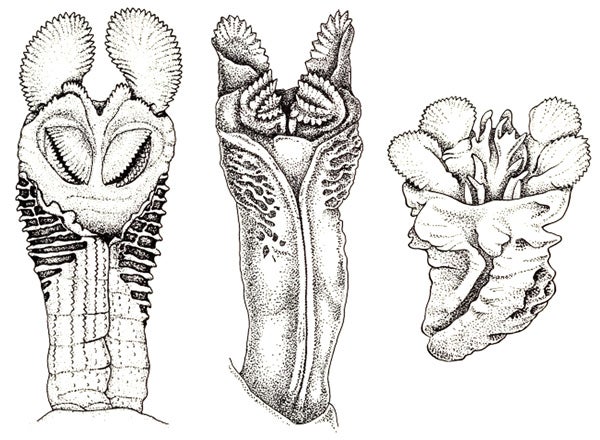
Believe it or not, these are chameleon penises, or hemipenes. As is typical for squamates, the organs are paired (hence 'hemipenis' = 'half penis'). From left to right, these hemipenes belong to Chamaeleo senegalensis, C. calyptratus and T. oweni. All are from Klaver & Böhme (1986).
During the mid-1980s, Charles Klaver & Wolfgang Böhme published a landmark study in which they showed that chameleon hemipenis and lung diversity was such that the previous ‘two genera system’ really didn’t reflect the variation within the group. Their study includes a substantial number of illustrations of chameleon hemipenes, many of which are remarkably elaborate and bristling with papillae, serrated ornaments called rotulae, spiky horns and lips flanking the seminal sulcus. As I’ve said before (in connection with snakes), experts in squamate identification are often hemipenis experts, no offence intended.
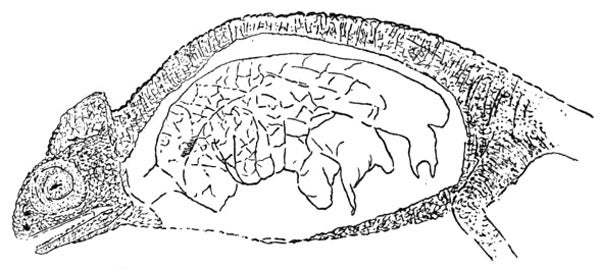
Diagram showing complex, internally partitioned lungs with finger-like side branches. This diagram is from Seeley (1901), a book on pterosaurs.
Oh, and, yeah, lungs: chameleon lungs are really variable in terms of complexity and in how many chambers and side-branches they have - the complex ones are among the most complex lungs of any non-bird reptile. Anyway, while Chamaeleo and Brookesia were distinct enough to warrant the recognition of two ‘subfamiles’ within Chamaeleonidae (Chamaeleoninae and Brookesiinae, respectively), both Chamaeleo and Brookesia needed splitting up (Klaver & Böhme 1986).
Of Rhampholeon and Rieppeleon. According to Klaver & Böhme (1986), a set of mainland African species previously included with Brookesia differed from the others (all of which are Madagascan) in having (short) horns and an ‘advanced’ karyotype. The old name Rhampholeon, originally published in 1874, was resurrected for them, and today they’re generally called African leaf chameleons or pygmy chameleons. They’re cute.
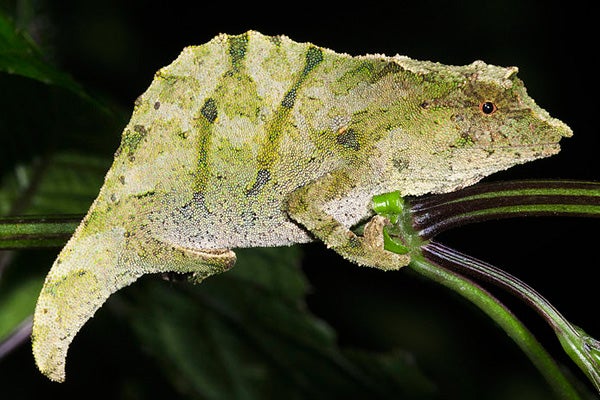
Stump-tailed chameleon Rhampholeon moyeri photographed in Udzungwa Moutains National Park, Tanzania. Image by Martin Nielsen, CC BY-SA 4.0.
However, despite being initially regarded as close to Brookesia, more recent phylogenetic work has shown that they don’t group together with them at all, and are in fact chamaeleonine chameleons (Raxworthy et al. 2002, Townsend et al. 2011, Tolley et al. 2013). Some studies actually find Rhampholeon to be embedded within the chamaeleonine clade and close to Calumma, Furcifer and Trioceros (all of which we’ll discuss later) (Townsend et al. 2011). A more recent study that analysed a far more extensive molecular dataset (Tolley et al. 2013), however, found Rhampholeon to be the sister-group to virtually all other chamaeleonines.
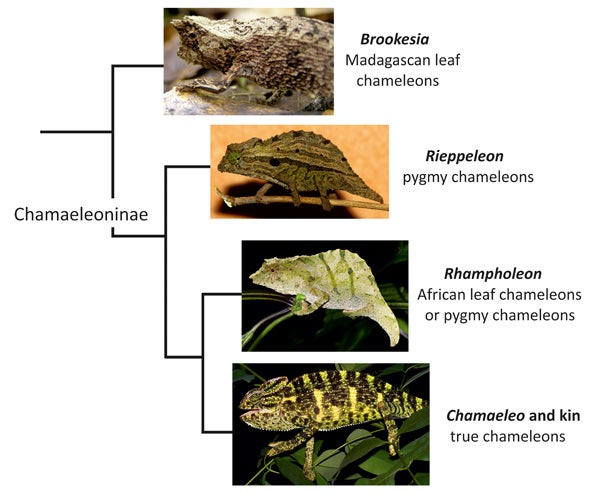
Highly simplified chameleon cladogram, based mostly on Tolley et al. (2013). Brookesia by Frank Wouters, CC BY-SA 2.0; Rieppeleon by R. J. Blach, CC BY-SA 3.0; Rhampholeon by Martin Nielsen, CC BY-SA 4.0; Chamaeleo by Raju Kasambe, CC BY-SA 3.0.
There are about 18 living Rhampholeon species (four of which were named in 2014), and such is the morphological and molecular diversity within the group that several clades within it have been recognised and named: Rhampholeon (for the R. spectrum clade), Bicuspis and Rhinodigitum (Matthee et al. 2004).

Rieppeleon brevicaudatus, so cute! Image at left by R. J. Blach, CC BY-SA 3.0. Image at right in public domain. The comparatively long tails show that these animals are males.
Furthermore, some taxa once included within Rhampholeon are not necessarily closer to Rhampholeon than they are to other chameleons. These species are now recognised as another distinct lineage termed Rieppeleon, named for herpetologist and palaeontologist Olivier Rieppel (Matthee et al. 2004). And according to recent molecular phylogenies (Townsend et al. 2011, Tolley et al. 2013), Rieppeleon is outside the clade that includes all other chamaeleonines, with one exception (a taxon I’ll discuss later). So… Rieppeleon, once included within Rhampholeon and regarded as a brookesiine, is not close to Brookesia and is not a brookesiine chameleon at all, and – while it is a chamaeleonine chameleon – it isn’t especially close to Rhampholeon either! There’s more to say, since its position within phylogeny tells us much about chameleon biogeographical history. I’ll come back to that later.
If, at this stage, you’re thinking that chameleon taxonomy has become a lot more complicated than you remember, I think that this is very much because that ‘two genera’ ‘conventional’ taxonomy failed to appropriately reflect the diversity and evolutionary history of these animals.
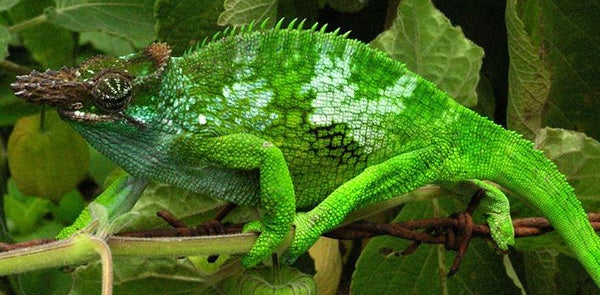
A hint of what's left to come -- this is Kinyongia! Image by Ales.kocourek, CC BY 2.0.
Have to stop there. More chameleons next! For previous Tet Zoo articles on iguanian lizards, see...
Harduns and toad-heads; a tale of arenicoly and over-looked convergence
The Squamozoic actually happened (kind of): giant herbivorous lizards in the Paleogene
Australia, land of dragons (by which I mean: agamids) (part I)
Refs - -
Klaver, C. J. J. & Böhme, W. 1986. Phylogeny and classification of the Chamaeleonidae (Sauria) with special reference to hemipenis morphology. Bonner Zoologische Monographien 22, 1-64.
Martin, J. 1992. Chameleons: Nature’s Masters of Disguise. Blandford, London.
Matthee, C. A., Tilbury, C. R. & Townsend, T. 2004. A phylogenetic review of the African leaf chameleons: genus Rhampholeon (Chamaeleonidae): the role of vicariance and climate change in speciation. Proceedings of the Royal Society of London B 271, 1967-1975.
Raxworthy, C. J., Forstner, M. R. J. & Nussbaum, R. A. 2002. Chameleon radiation by oceanic dispersal. Nature 415, 784-787.
Seeley, H. G. 1901. Dragons of the Air. Appleton and Company, London.
Tolley, K. A., Townsend, T. M. & Vences, M. 2013. Large-scale phylogeny of chameleons suggests African origins and Eocene diversification. Proceedings of the Royal Society of London B, 280, 20130184.
Townsend, T. M., Tolley, K. A., Glaw, F., Böhme, W. & Vences, M. 2011. Eastward from Africa: palaeocurrent-mediated chameleon dispersal to the Seychelles islands. Biology Letters 7, 225-228.